How to Cite | Publication History | PlumX Article Matrix
Suresh Kumar P. S. and S. A. Mohite*
College of Fisheries, Ratnagiri - 415 629 India.
ABSTRACT: Nemipterus japonicus, the Japanese threadfin bream (Family : Nemipteridae), has wide spread distribution throughout the Indian Ocean and is distributed in the tropical waters from 300N-100S latitude. Out of the three species of Nemipterus, N. japonicus is the most dominant among all the species landed along the Ratnagiri coast of Maharashtra and has a great demand for fresh consumption as well as in surimi industry. Present study analyses the mophometric relationships between the Total length (LT) and other characters such as Fork length (LF’), Standard length (LS), 4. Snout length (UO), Orbital diameter (OO’), Greatest pupil diameter (Eg), Greatest iris diameter (Ig), Dorsal fin base length (D1D1’), Ventral fin length (Vh), Anal fin base length (AA’), Girth height (g), Anal fin height (Ah), Pectoral fin length (Ph), Dorsal caudal fin length (Ch’), Ventral caudal fin length (Ch’’). Relationships statistically calculated are : LF’ = -0.925 + 0.7317 LT, LS = 5.677 + 0.918, UO = 1.7460 + 0.038 LT, OO’ = 1.7244 + 0.0903 LT, Eg = 0.8385 + 0.0261 LT, Ig = -1.4988 + 0.0438 LT, D1D1’ = -0.5988 + 0.2978 LT, Vh = 0.8925 + 0.2042 LT, AA’ = 0.498 + 0.14 LT, g = 0.9621 + 0.1838 LT, Ah = 0.3583 + 0.102 LT, Ph = -0.996 + 0.225 LT, Ch’ = 0.1226 + 0.3881 LT and Ch’’ = 0.6625 + 0.1838 LT.
KEYWORDS:
Nemipterus japonicas; Morphometric relationships
Download this article as:| Copy the following to cite this article: Kumar S. P. S, Mohite S. A. Study of Relationships Between the Morphometric Characters of the Threadfin Bream, Nemipterus japonicas. Biosci Biotech Res Asia 2011;8(2) |
| Copy the following to cite this URL: Kumar S. P. S, Mohite S. A. Study of Relationships Between the Morphometric Characters of the Threadfin Bream, Nemipterus japonicas. Biosci Biotech Res Asia 2011;8(2). Available from: https://www.biotech-asia.org/?p=9504/ |
Introduction
Nemipterus japonicus, the Japanese threadfin bream (Family : Nemipteridae), has wide spread distribution throughout the Indian Ocean and is distributed in the tropical waters from 300N-100S latitude. It is benthic species, very abundant in coastal waters, found on mud or sand bottoms in 5 to 80 m, usually in schools. The principal regions supporting Nemipterus fishery are the Mediterranean region, Red sea, east and west coasts of India, Sri Lanka, Andaman, west coast of Malaya peninsula, Singapore, Sumatra, Indonesia Borneo, North Celebes, South China Sea, Philippines, and Southern Japan. Major landings of N. japonicus are also reported from Ratnagiri. The important species forming the nemipterid fishery along Ratnagiri coast are N.japonicus, (Bloch, 1791), N. mesoprion (Bleeker, 1853) and N. delagoae (Smith, 1941), but N. japonicus is the most dominant among all the species landed along the Ratnagiri coast of Maharashtra. Due to its use in the surimi industry it is in great demand. But due to the continuous exploitation, a decreasing trend has been observed in this fishery along the Maharashtra coast. The present study was hence undertaken to study the morphometric characteristics of N. japonicus and to assess the relationships between them.
Materials and method
Samples collected from landing centre were brought to the laboratory. Collected samples were washed properly with fresh water. Each specimen was properly placed on measuring board, after fixing the tip of snout of the specimen to the vertical side of measuring board, for measuring total length, standard length and fork length. Then with the help of divider snout length, orbital diameter, dorsal fin base length, ventral fin length, anal fin base length, pectoral fin base length, anal fin base length, anal fin height, dorsal caudal fin length, ventral caudal fin length, greatest iris diameter, greatest pupil diameter, girth height were measured.(Fig. 1)
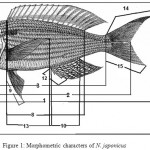 |
Figure 1: Morphometric characters of N. japonicus.
|
The Morphometric characters measured were as follows: (FAO, 1974)
1) Total length (LT), 2) Fork length (LF’), 3) Standard length (LS), 4) Snout length (UO),
5) Orbital diameter (OO’), 6) Greatest pupil diameter (Eg), 7) Greatest iris diameter (Ig),
8) Dorsal fin base length (D1D1’), 9) Ventral fin length (Vh), 10) Anal fin base length (AA’), 11) Girth height (g), 12) Anal fin height (Ah), 13) Pectoral fin length (Ph), 14) Dorsal caudal fin length (Ch’) and 15) Ventral caudal fin length (Ch’’)
Results
Morphometric characters of all the fish collected during present investigation have been worked out and compared. The various body part measurements of the fish are as given. Body depth 2.7 to 3.5 in SL; snout length equal to or greater than diameter of eye; diameter of eye 3.2 to 4.4 in head length; lower margin of eye above a line from tip of snout to upper base of pectoral fin; interorbital width 1.0 to 1.9 in eye; suborbital depth 1.0 to 1.9 in eye diameter; a line drawn up from the posterior edge of suborbital reaching the dorsal profile 2 to 4 scale rows before origin of dorsal fin; preopercle naked width 1.1 to 2.0 in scaly width; pectoral fins very long, 1.0 to 1.3 in head length, reaching to or just beyond level of origin of anal fin; pelvic fins moderately long, 1.2 to 1.6 in head length, reaching to or just beyond anus; caudal fin moderately forked, upper lobe slightly longer than lower and produced into a short or moderately long filament; 4 or 5 pair of small curved canines anteriorly in upper jaw; gill rakers 14 to 17.
The morphometric characters of all the fish collected during present investigation have been worked out and compared. Characters with total length were analysed to find out the degree of correlation. The comparative account of various relationships between different morphometric measurements have been indicated by Fig. 2-15 against total length and Table 1 indicate values of their constants (a and b) and coefficient of correlation (r).
All the mophometric characters were found to be directly proportional to the LT. Following relationships were statistically calculated.
LF’ = -0.925 + 0.7317 LT (Fig. 2), LS = 5.677 + 0.918 LT (Fig. 3), UO = 1.7460 + 0.038 LT (Fig. 4), OO’ = 1.7244 + 0.0903 LT (Fig. 5), Eg = 0.8385 + 0.0261 LT (Fig. 6), Ig = -1.4988 + 0.0438 LT (Fig. 7), D1D1’ = -0.5988 + 0.2978 LT (Fig. 8), Vh = 0.8925 + 0.2042 LT (Fig. 9), AA’ = 0.498 + 0.14 LT (Fig. 10), g = 0.9621 + 0.1838 LT (Fig. 11), Ah = 0.3583 + 0.102 LT (Fig. 12), Ph = -0.996 + 0.225 LT (Fig. 13), Ch’ = 0.1226 + 0.3881 LT (Fig. 14) and Ch’’ = 0.6625 + 0.1838 LT (Fig. 15)
Table 1: Linear regression equations coefficients for the relationship of total length (LT) and various body parts for Nemipterus japonicus.
| Characteristics | Regression parameters | ||||
| Sr. No. | Compared with Total length (LT) | a | b | r | |
| 1 | LF’ | -0.925 | 0.7317 | 0.91 | |
| 2 | LS | 5.677 | 0.9180 | 0.96 | |
| 3 | UO | 1.7460 | 0.0380 | 0.91 | |
| 4 | OO’ | 1.7244 | 0.0903 | 0.61 | |
| 5 | Eg | 0.8385 | 0.0261 | 0.85 | |
| 6 | Ig | -1.4988 | 0.0438 | 0.81 | |
| 7 | D1D1’ | -0.5988 | 0.2918 | 0.84 | |
| 8 | Vh | 0.8925 | 0.2042 | 0.85 | |
| 9 | AA’ | 0.4980 | 0.1400 | 0.96 | |
| 10 | g | 0.9621 | 0.1838 | 0.96 | |
| 11 | Ah | 0.3583 | 0.1020 | 0.95 | |
| 12 | Ph | -0.9960 | 0.2250 | 0.89 | |
| 13 | Ch’ | 0.1226 | 0.3881 | 0.85 | |
| 14 | Ch’’ | 0.6625 | 0.1838 | 0.93 | |
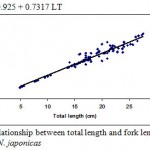 |
Figure 2: Relationship between total length and fork length (LF’) in N. japonicus.
|
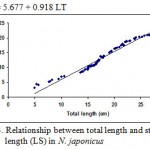 |
Figure 3: Relationship between total length and standard length (LS) in N. japonicus.
|
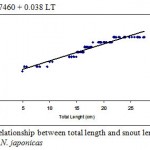 |
Figure 4: Relationship between total length and snout length (UO) in N. japonicus. |
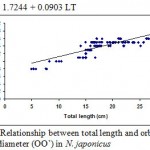 |
Figure 5: Relationship between total length and orbital diameter (OO’) in N. japonicus.
|
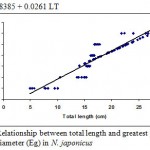 |
Figure 6: Relationship between total length and greatest pupil diameter (Eg) in N. japonicus.
|
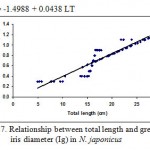 |
Figure 7: Relationship between total length and greatest iris diameter (Ig) in N. japonicus.
|
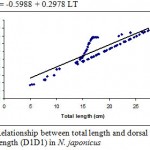 |
Figure 8: Relationship between total length and dorsal fin base length (D1D1) in N. japonicus.
|
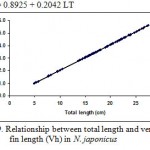 |
Figure 9: Relationship between total length and ventral fin length (Vh) in N. japonicus.
|
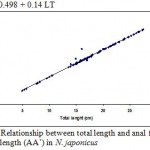 |
Figure 10: Relationship between total length and anal fin base length (AA’) in N. japonicus.
|
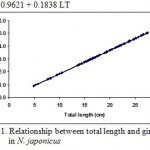 |
Figure 11: Relationship between total length and girth (g) in N. japonicus.
|
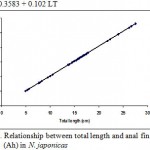 |
Figure 12: Relationship between total length and anal fin height (Ah) in N. japonicus.
|
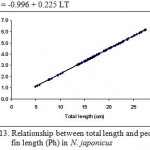 |
Figure 13: Relationship between total length and pectoral fin length (Ph) in N. japonicus.
|
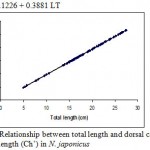 |
Figure 14: Relationship between total length and dorsal caudal fin length (Ch’) in N. japonicus.
|
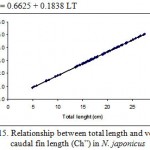 |
Figure 15: Relationship between total length and ventral caudal fin length (Ch”) in N. japonicus.
|
Discussion
In the present study, the total length of N. japonicus collected along the Ratnagiri coast ranged from 49 to 275 mm. The morphometric equations for the samples collected along the Ratnagiri coast were LF’ = -0.925 + 0.7317 LT, LS = 5.677 + 0.918 LT, UO = 1.7460 + 0.038 LT, OO’ = 1.7244 + 0.0903 LT, Eg = 0.8385 + 0.0261 LT, Ig = -1.4988 + 0.0438 LT, D1D1’ = -0.5988 + 0.2978 LT, Vh = 0.8925 + 0.2042 LT, AA’ = 0.498 + 0.14 LT, g = 0.9621 + 0.1838 LT, Ah = 0.3583 + 0.102 LT, Ph = -0.996 + 0.225 LT, Ch’ = 0.1226 + 0.3881 LT, Ch’’ = 0.6625 + 0.1838 LT. Though, the biology of N. japonicus has been studied by many workers with respect to length-weight (Acharya and Dwivedi, 1981; Hoda, 1976; Vinci and Nair, 1974; Vivekanandan and James, 1984.) biology (Bakhsh, 1994; Eggleston, 1972; Kuthalingam, 1965; Krishnamoorti, 1971) but morphomertic relationships between LT and LF’, UO, OO’, D1D1, Vh, Ph, AA’, Ah, Ch, Ch’, Ig, Eg were not used as the identifying characters in the studies.
Lee (1974) reported that for males and females of N. japonicus from Hong Kong, the maximum recorded length used as one of the morphometric characters was 31.1 and 25.7 cm and the maximum age observed 7 and 8 years respectively. Murty (1982) studied the age and growth of N. mesoprion from Kakinada. This species attained 140 mm, 185 mm and 205 mm at the completion of 1, 2 and 3 rd year respectively. According to Vinci (1982) N. japonicus attains a length of 136 mm at the end of one year, 186 mm at the end of second year and 236 mm at the end of third year. Murty (1984) used the total length for growth analysis of N. japonicus and reported that it attained 185mm. 255 mm and 285 mm at the completion of first, second and third year respectively at Kakinada. Lelli et al., (2008) studied 13 morphometric characters of N. randalli (Russell) and found differences for most of them except for the eye diameter, pelvic and pectoral fins of the Lebanese specimens as compared to the Western Indian Ocean individuals, indicating their use as taxonomic tool.
During the present study all the morphometric characteristics were correlated to the total length of the fish. The equations calculated statistically could be used as the tool for identification of N. japonicas from the other two species reported along the Ratnagiri coast of Maharashtra.
References
- Acharya, P. and Dwivedi, S.N. Condition factor and length weight relationship of Nemipterus japonicus (Bloch) off Bombay coast. J. Indian Fish.Assoc,10 & 11:37- 44 (1981).
- Bakhsh, A.A. The Biology of Thread Bream, Nemipterus japonicus (Bloch) from the Jizan Region of the Red Sea. special issue:Symp. On Red sea Mar. Environ., Jeddah. J. KAU: Mar. Sci., 7: 179-189 (1994).
- Eggleston, D. Patterns of biology in Nemipteridae. J. Mar .Biol. Assoc. India, 14 :357-364
- (1972).
- FAO. Part 2 – Methods of resource investigation and their application, Manual of fisheries science, FAO Fisheries Technical Paper No. 115, revision 1, Rome, Italy (1974).
- Hoda, S.M.S. Length-weight and volume relationship in the threadfin bream, Nemipterus japonicus from the Pakistan coast. J. Mar .Biol. Assoc. India, 18:421-430 (1976).
- Krishnamoorti, B. Biology of Threadfin bream, Nemipterus japonicus (Bloch). Indian Fish. 18:1-21 (1971).
- Kuthalingam, M.D.K. Notes on some aspects of the fishery and biology of Nemipterus japonicus (Bloch) with special references to the feeding behaviour. Indian Fish. 12:500-506 (1965).
- Lee, C.K.C. The exploitation of Nemipterus japonicus (Bloch) by Hong Kong vessels in 1972-73. Pacif.Sci.Assoc.,Spec.Symp.Mar.Sci., 7-16 Dec. 1973, Hong Kong.: 48-52 (1974).
- Lelli. S., Colloca F., Carpentieri, P. and Russell, B.C. The threadfin bream Nemipterus randalli (Russell, 1986) (Perciformes ; Nemipteridae) in the eastern Mediterranean sea. J. Fish Biology. 73 : 740 -745 (2008).
- Murty, V.S. Observations on some aspects of biology of threadfin breams Nemipterus mesoprion (Bleeker) from Kakinada along the east coast of India. Indian J. Fish. 12:199-207 (1982).
- Murty, V.S. Observations on the fisheries of Threadfin breams (Nemipteridae) and on the biology of Nemipterus japonicus (Bloch). from Kakinada. Indian J. Fish. 31:1-18 (1984).
- Vinci, G. K. Threadfin bream (Nemipterus) resources along the Kerala coast with notes on biology of Nemipterus japonicus (Bloch). Indian J. Fish., 29: 37-49 (1982).
- Vinci, G. K. and Nair, A. K. K. Length weight relationship in the threadfin bream, Nemipterus japonicus along the Kerala coast. Indian J. Fish, 21:299-302 (1974).
- Vivekanandan,E. and James, D. B. Length-weight relationship in four species of threadfin breans from Madras. J. Mar .Biol. Assoc. India, 26 :132-135 (1984).

This work is licensed under a Creative Commons Attribution 4.0 International License.





